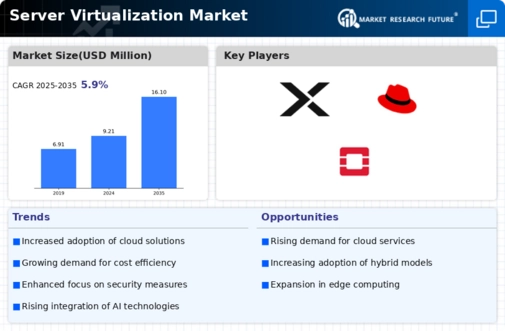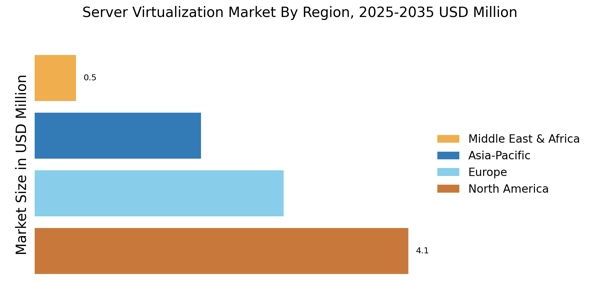Rising Demand for Cost Efficiency
The Server Virtualization Market is experiencing a notable surge in demand for cost efficiency among enterprises. Organizations are increasingly seeking ways to optimize their IT expenditures, and server virtualization offers a compelling solution. By consolidating multiple physical servers into fewer virtual machines, companies can significantly reduce hardware costs, energy consumption, and maintenance expenses. According to recent data, businesses that implement server virtualization can achieve up to 30% savings on operational costs. This trend is particularly pronounced in small to medium-sized enterprises, which often operate with limited budgets. As the need for cost-effective IT solutions continues to grow, the Server Virtualization Market is likely to expand, driven by the financial benefits associated with virtualization technologies.
Growing Adoption of Remote Work Policies
The Server Virtualization Market is witnessing a significant shift due to the growing adoption of remote work policies. As organizations transition to flexible work arrangements, the need for scalable and accessible IT infrastructure becomes increasingly apparent. Server virtualization enables companies to provide remote employees with secure access to applications and data, regardless of their physical location. This trend is supported by data indicating that organizations leveraging virtualization technologies can enhance employee productivity by up to 25%. Furthermore, the ability to manage resources efficiently in a virtualized environment aligns with the evolving demands of the modern workforce. Consequently, the Server Virtualization Market is likely to expand as businesses seek to implement solutions that support remote work initiatives.
Advancements in Virtualization Technologies
The Server Virtualization Market is being propelled forward by continuous advancements in virtualization technologies. Innovations such as containerization and hyper-converged infrastructure are reshaping the landscape, offering enhanced performance and flexibility. These technologies allow organizations to deploy applications more rapidly and efficiently, which is crucial in today's fast-paced business environment. Recent market analyses suggest that the adoption of hyper-converged infrastructure is expected to grow at a compound annual growth rate of over 25% in the coming years. As organizations seek to leverage these cutting-edge solutions, the Server Virtualization Market is likely to benefit from increased investment in advanced virtualization technologies, driving further growth and development.
Increased Focus on Disaster Recovery Solutions
In the Server Virtualization Market, there is an increasing emphasis on disaster recovery solutions. Organizations are recognizing the critical importance of ensuring business continuity in the face of potential disruptions. Virtualization technologies facilitate efficient backup and recovery processes, allowing businesses to quickly restore operations after an incident. Recent statistics indicate that companies utilizing server virtualization for disaster recovery can reduce downtime by up to 50%. This capability is particularly appealing to sectors such as finance and healthcare, where data integrity and availability are paramount. As awareness of the need for robust disaster recovery strategies grows, the Server Virtualization Market is poised for growth, driven by the demand for reliable and efficient recovery solutions.
Regulatory Compliance and Data Security Concerns
In the Server Virtualization Market, regulatory compliance and data security concerns are becoming increasingly prominent. Organizations are under pressure to adhere to stringent regulations regarding data protection and privacy, which necessitates robust security measures. Server virtualization can enhance security by isolating virtual machines and implementing advanced security protocols. Data indicates that companies utilizing virtualization technologies can improve their compliance posture by up to 40%. This is particularly relevant in industries such as finance and healthcare, where regulatory requirements are stringent. As businesses prioritize compliance and security, the Server Virtualization Market is expected to grow, driven by the need for solutions that address these critical challenges.


















Leave a Comment